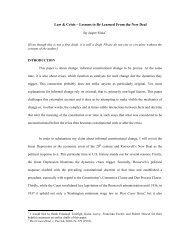updating brignoni-ponce - New York University School of Law
updating brignoni-ponce - New York University School of Law
updating brignoni-ponce - New York University School of Law
Create successful ePaper yourself
Turn your PDF publications into a flip-book with our unique Google optimized e-Paper software.
2008] UPDATING BRIGNONI-PONCE 575<br />
danger. In doing so, the Court suggested that the presence <strong>of</strong> undocumented<br />
immigrants itself constitutes a threat to public safety. This<br />
reformulation <strong>of</strong> the public safety consideration helped the Court to<br />
justify the application <strong>of</strong> the reasonable suspicion standard instead <strong>of</strong><br />
probable cause to roving immigration stops. 43<br />
After deciding to use the reasonable suspicion standard, the Court<br />
then addressed the extent to which <strong>of</strong>ficers could use a person’s apparent<br />
ancestry to justify a stop. 44 Thus, the Court did not, at least explicitly,<br />
take into consideration any intrusions into personal liberty caused<br />
by a race-based stop. The Court recognized that many native-born<br />
and naturalized citizens have physical characteristics identified with<br />
Mexican ancestry and that, even in the border area, a relatively small<br />
proportion <strong>of</strong> them are immigrants. 45 Therefore, <strong>of</strong>ficers would not be<br />
justified in stopping all Mexican-Americans to ask about their immigration<br />
status. 46 Yet, the Court still found that the “likelihood that any<br />
given person <strong>of</strong> Mexican ancestry is an alien is high enough to make<br />
Mexican appearance a relevant factor.” 47 The Court did not cite any<br />
statistics about the proportion <strong>of</strong> immigrants among persons <strong>of</strong> Mexican<br />
appearance to support this conclusion. Instead, the Court listed<br />
other factors that Border Patrol <strong>of</strong>ficers could rely on in forming a<br />
reasonable suspicion: (1) characteristics <strong>of</strong> the area where the vehicle<br />
is stopped; (2) proximity <strong>of</strong> that area to the border; (3) “usual patterns<br />
<strong>of</strong> traffic on that particular road”; (4) recent experience with immi-<br />
43. See id. at 883. Justice Douglas concurred in the judgment but vigorously attacked<br />
the standard <strong>of</strong> “reasonable suspicion” adopted by the majority. Id. at 888–90<br />
(Douglas, J., concurring in the judgment). He repeated the concern he voiced in his<br />
Terry v. Ohio dissent that a suspicion test, rather than a probable cause test, allows<br />
<strong>of</strong>ficers to “stop citizens on the highway on the flimsiest justifications and does not<br />
provide citizens sufficient protection from governmental intrusion.” Id. at 890. He<br />
acknowledged that the extent to which the suspicion test restrains the police in practice<br />
will depend on the future decisions <strong>of</strong> the Court. Id.<br />
44. Id. at 885–87 (majority opinion).<br />
45. Id. at 886. According to the 1970 census and the INS figures for alien registration<br />
in 1970, persons registered as Mexican immigrants comprised 12.4% <strong>of</strong> the<br />
1,619,064 persons <strong>of</strong> Mexican origin in Texas; 8.5% <strong>of</strong> the 111,049 persons <strong>of</strong> Mexican<br />
origin in <strong>New</strong> Mexico; 14.2% <strong>of</strong> the 239,811 persons <strong>of</strong> Mexican origin in Arizona;<br />
and 20.4% <strong>of</strong> the 1,857,267 persons <strong>of</strong> Mexican origin in California. Id. at 886<br />
n.12. One commentator concludes from the Court’s statistics that in 1975 “almost<br />
two <strong>of</strong> every three Mexicans in the four border states were undocumented.” Robert<br />
Alan Culp, Note, The Immigration and Naturalization Service and Racially Motivated<br />
Questioning: Does Equal Protection Pick Up Where the Fourth Amendment Left Off?,<br />
86 COLUM. L. REV. 800, 816 & n.124 (1986). However, U.S. Census Bureau information<br />
from 1980 suggests that really only one-eighth <strong>of</strong> the Latino population in<br />
those border states was undocumented. Id. at 817 n.125.<br />
46. Brignoni-Ponce, 422 U.S. at 886–87.<br />
47. Id.
















